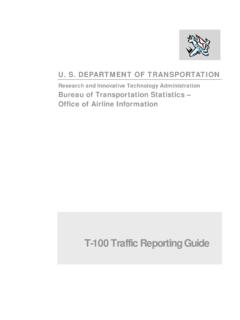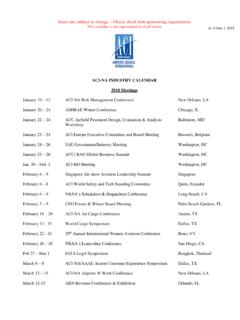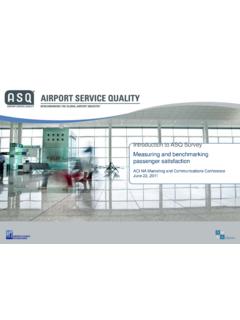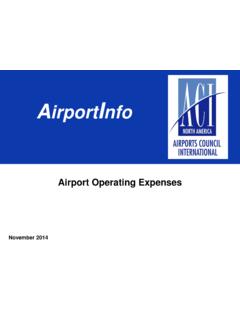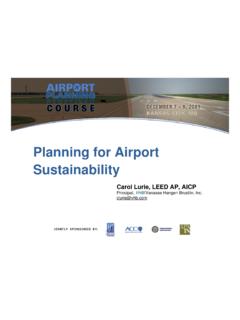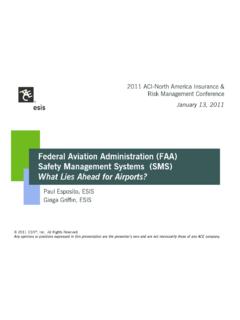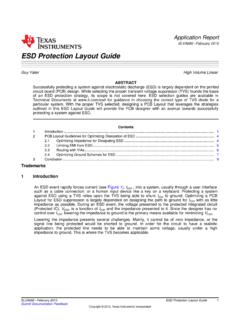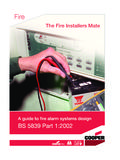Transcription of Security Checkpoint Layout Design and …
1 Version: 1 Revision: 00-00 Date of Revision: November 7, 2006 Implementation Date: November 7, 2006 Checkpoint Layout Design guide AVIATION Security SSEECCUURRIITTYY CCHHEECCKKPPOOIINNTT LLAAYYOOUUTT DDEESSIIGGNN // RREECCOONNFFIIGGUURRAATTIIOONN GGUUIIDDEE PREPARED FOR THE TRANSPORTATION Security ADMINISTRATION PREPARED BY PASSENGER SCREENING TASK FORCE ARCHITECTURE AND TECHNOLOGY WORKGROUP Version: 1 Revision: 00-00 Date of Revision: November 7, 2006 Implementation Date: November 7, 2006 Checkpoint Layout Design guide TABLE OF CONTENTS SECTION NO. PAGE NO. General Checkpoint Essential Planning Operational SSCP SSCP Review, Approval and Project Design Designing for the Designing for the Elements of the Primary Checkpoint A Prescreening Preparation Instruction B Queuing C - Divest and Composure D Walk-Through Metal Detector (WTMD).
2 14 E Carry-On Baggage X-ray (TRX) E Explosive Detection Systems (EDS)..18 F Explosives Trace Detection (ETD) G Explosives Trace Portals (ETP)..21 H/I Passenger Containment and J Non-Metalic K Non-Metallic ADA L SSCP Adjacent Supplementary Checkpoint Egress Seating Law Enforcement Officer Supervisor Space for TSA Private Screening CCTV Data SSCP Wireless Access Exit Lane Features of Standard SSCP Layout Design SSCP Spacing i Version: 1 Revision: 00-00 Date of Revision: November 7, 2006 Implementation Date: November 7, 2006 Checkpoint Layout Design guide TSA Approved 2-to-1 Design with Holding 2-to-1 Design with Holding/Wanding 2-to-2 Design with Holding 2-to-2 Design with Holding/Wanding 2-to-2 Design with Wanding 2-to-1 Design with Long Neck Wanding 2-to-2 Design with Long Neck Wanding 1-to-1 Single Lane Design with Holding 1-to-1 Single Lane Design with Wanding Alternative 2-to-2 and 1-to-1 ETP Designs with Wanding and Holding 1-to-1 Checkpoint EDS Designs with Holding Combination of Different Electrical and IT Data Power and IT Power and Data Power Placement Safety Participation in SSCP Appendix A Appendix B Checkpoint Equipment Request ii Version: 1 Revision: 00-00 Date of Revision: November 7, 2006 Implementation Date.
3 November 7, 2006 Checkpoint Layout Design guide LIST OF FIGURES FIGURE NO. PAGE NO. Figure 1-1. Construction Review and Approval Figure 1-2. Checkpoint Equipment Request Figure 2-1. Elements of a Standard TSA Figure 2-2. Typical SSCP Layout and Figure 2-3. SSCP Large Poster Figure 2-4. SSCP Simple Signage, Dispensers and Floor Figure 2-5. Queuing Figure 2-6. Typical Divest/Composure Figure 2-7. Typical WTMD Figure 2-8. Current TSA Approved Figure 2-9. Standard Size and Layout of an X-ray Figure 2-10. TSA Approved Carry-On Baggage Figure 2-11. Space Required for Typical Figure 2-12. Comparison of Checkpoint EDS Scanners (units in inches)..19 Figure 2-13. Typical ETD Machine and Figure 2-14.
4 TSA Approved ETD Figure 2-15. Space Required for Typical Figure 2-16. Typical Holding Figure 2-17. Typical Holding/Wanding Figure 2-18. Typical Wanding Figure 2-19. Typical Long Neck Wanding Figure 2-20. Example of a 4 Non-metallic Figure 2-21. Typical ADA Figure 2-22. STSO Figure 2-23. Modular Paneled Privacy Figure 3-1. Combined 9 Standard Checkpoint Figure 3-2. Advantages/Disadvantages of Design Layout Figure 3-3. Typical SSCP Spacing Figure 3-4. Example Layout of SSCP Minimum Spacing Figure 3-5. 2-to-1 Design with Holding Figure 3-6. 2-to-1 Design with Holding/Wanding Figure 3-7. 2-to-2 Design with Holding Figure 3-8. 2-to-2 Design with Holding/Wanding Figure 3-9. 2-to-2 Design with Wanding Figure 3-10. 2-to-1 Design with Long Neck Wanding Figure 3-11. 2-to-2 Design with Long Neck Wanding Figure 3-12.
5 1-to-1 Single Lane Design with Holding Figure 3-13. 1-to-1 Single Lane Design with Wanding iii Version: 1 Revision: 00-00 Date of Revision: November 7, 2006 Implementation Date: November 7, 2006 Checkpoint Layout Design guide Figure 3-14. 2-to-2 and 1-to-1 ETP Designs with Wanding and Holding Figure 3-15. 1-to-1 EDS Design with Wanding Station with Bag Search after Figure 3-16. 1-to-1 EDS Design with Holding Station with Bag Search after Figure 3-17. 1-to-1 EDS Design with Holding Station with Bag Search behind Figure 3-18. 6-Lane Checkpoint Design With Different Configurations Figure 4-1. IT Power and Data Drop Requirements (1 of 2)..55 Figure 4-1. IT Power and Data Drop Requirements (2 of 2)..56 Figure 4-2. Power and Data Receptacle Figure 4-3. Checkpoint Electrical Placement Figure 7-1. Checkpoint Equipment Request Form (page 1).
6 62 Figure 7-2. Checkpoint Equipment Request Form (page 2)..63 Figure 7-3. Checkpoint Equipment Request Form (page 3)..64 Figure 7-4. Checkpoint Equipment Request Form (page 4)..65 Figure 7-5. Checkpoint Equipment Request Form (page 5)..66 iv Version: 1 Revision: 00-00 Date of Revision: November 7, 2006 Implementation Date: November 7, 2006 Checkpoint Layout Design guide INTRODUCTION Over the past several years, a number of critically important Checkpoint Design elements have been identified and integrated to create a typical Transportation Security Administration (TSA) Security Screening Checkpoint (SSCP). This document expounds upon the Checkpoint Design planning as identified in the airport Security planning guide . The intent of this document is to provide lessons learned from that experience, and present ideas, technology and guidelines that shape the SSCP Design .
7 The information provided will prove useful to Federal Security Directors and staff, as well as, airport planners, architects, and engineers to assist in the Design or redesign of a SSCP. Each airport and airport terminal building is unique in terms of physical Design and operational requirements. Therefore, no single SSCP solution will work for all airports, or possibly even among multiple locations within the same airport. This section discusses where and how large an SSCP should be base on a variety of conditions. The location and size of the SSCP depends, among other things, on the type of risk that is present or anticipated, the type of operations at the airport, the passenger loads, and the character of the overall Design of the airport. Proper SSCP Design helps avoid a host of problems for the airport and airlines, including terminal and queuing congestion, delays, and unnecessary Security risks.
8 This document addresses the following topics: General Checkpoint Issues Essential Coordination Planning Considerations Elements of the SSCP SSCP Operational Efficiency SSCP Layout Standards SSCP Spacing Requirements SSCP Project Funding Designing for the Future. GENERAL Checkpoint ISSUES SSCPs are a critical element of an airport s terminal Security Design , and must be included in the planning, Design , and engineering phases of the project from its conception. It is dually important to engage airport and airline representatives early on in the project discussions. Performance requirement of a SSCP along with airport/airline responsibilities are described in a number of TSA regulatory documents, many of which are not available to the general public. Security screening is intended to prevent hijackings and deter the transport of any explosive, incendiary, or deadly and dangerous weapon aboard a commercial aircraft.
9 SSCPs provide 1 Version: 1 Revision: 00-00 Date of Revision: November 7, 2006 Implementation Date: November 7, 2006 Checkpoint Layout Design guide screening of passengers and their carry-on or personal items in addition to credentialed airport, airline and concession employees, and concession delivery personnel. Non-ticketed visitors are currently not allowed beyond Security screening Checkpoint . Design consideration must also be given to persons with disabilities using wheelchairs and other assistive devices. Among the general issues to consider are: Cost-effectiveness for airlines, airports, and TSA; Deterrence of potential adversaries, both in terms of actual detection of contraband of any kind, and in creating the maximum perception of effective Security measures; Effective and secure handling of goods and services other than individuals, required to cross from non-sterile area to sterile area; Safety and ergonomic Design ; Efficient and effective use of terminal space, providing more space for operational or revenue generating uses; Flexibility to accommodate highly-specialized equipment with constantly changing engineering requirements; Minimal interruption or delay to flow of air-travelers and others passing through the terminal from non-sterile public areas to sterile areas.
10 Operational flexibility in response to changes in passenger load, equipment use, and operational processes, including the increasing use of electronic identification media; Prevention of SSCP exit lane breaches for entry into sterile areas; Coordination of Heating, Ventilating and Air Conditioning (HVAC), electrical, lighting, telecommunications and electronic components of the SSCP; Protection of SSCP integrity when not in use; Space, including the availability of office space for Information Technology (IT) equipment and TSA staff work areas. ESSENTIAL COORDINATION Key individuals with TSA, co-located government agencies, airport and airline operations personnel should be partnered with throughout the stages of the SSCP Design process. Many airports are subject to local, city and state building codes, mutual aid agreements with local law enforcement and emergency responders, and may be party to other arrangements, such as or a joint military presence on the airport, that could strongly affect many or all areas of Security Design .
